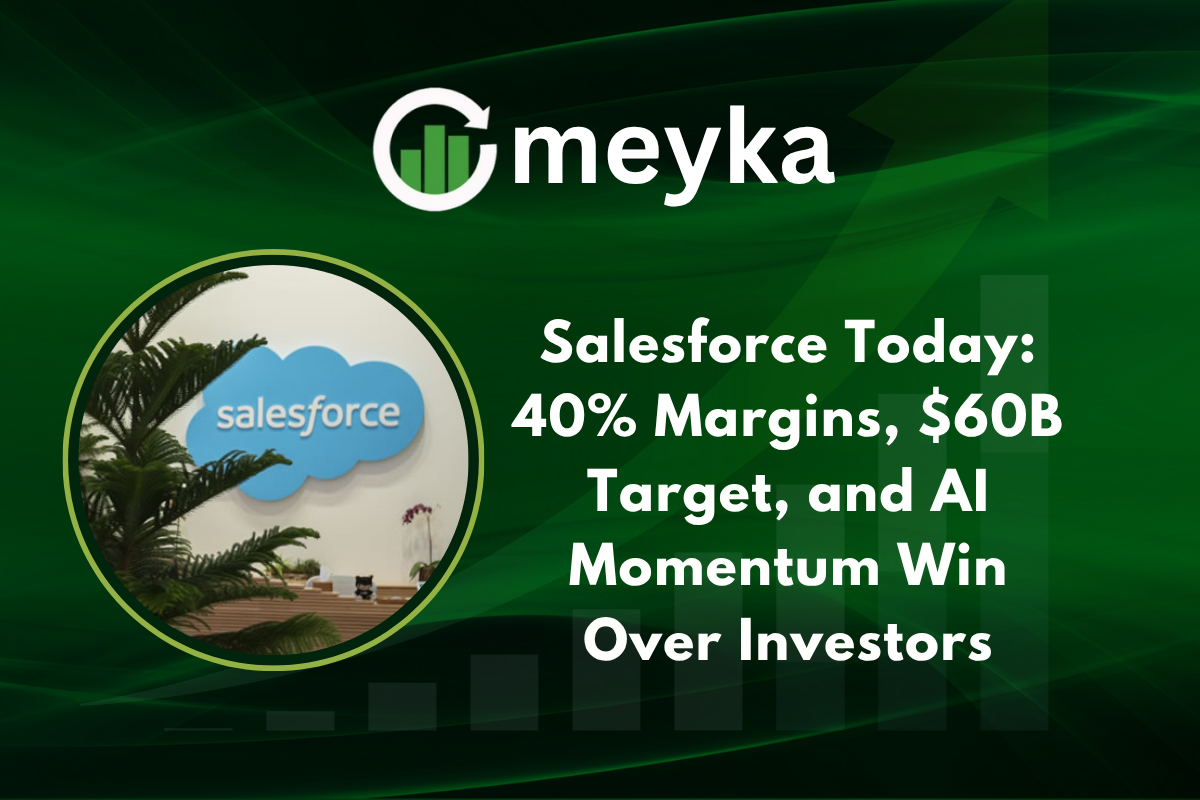Salesforce Today: 40% Margins, $60B Target, and AI Momentum Win Over Investors
Salesforce stunned investors with bold targets, and the market took notice. The company set a $60 billion revenue goal for 2030. It also signalled a drive toward 40 percent operating margins. The firm says AI, led by the Einstein 1 Platform, will help get it there. Stock moves and analyst notes show renewed confidence.
Why are investors excited? The mix of growth and margin discipline answers that question.
Salesforce sets a $60 billion target, and why it matters
The Salesforce (CRM) plan is simple to read, and hard to deliver. Hitting $60 billion by 2030 means steady revenue growth for years. The company will need to sell more software, win bigger deals, and increase product monetization.
Analysts say the target raises expectations, but it also signals a clear long-term strategy. This kind of roadmap matters to large institutional investors who value visibility and scale.
Can Salesforce really hit $60 billion? The answer depends on execution, cross-sell, and AI adoption across customers.
Salesforce AI Strategy: Einstein 1 and the product push
Salesforce’s AI push centers on Einstein 1, a platform that embeds generative AI across the CRM stack. The company aims to automate workflows, personalize customer journeys, and speed up sales cycles.
Executives argue that AI will increase customer ROI, and that should make renewals and expansions easier. Analysts point to the AI story as the key multiplier for revenue per customer. If AI drives measurable outcomes, then Salesforce can justify price and margin expansion.
So, what makes this AI momentum special? It ties revenue growth to product value, not just headcount or selling effort.
Salesforce and the promise of 40 percent operating margins
Management also mentioned a path to 40 percent operating margins, a figure that excites profit focused investors. Reaching that level means the company must gain strong operating leverage.
That comes from higher software margins, better cloud efficiencies, and disciplined spending. Analysts noted the plan is feasible if revenue grows faster than costs, and if AI tools reduce manual work across support and sales. Markets often reward companies that promise both scale and margin.
Can its focus on efficiency sustain margins? It can, if the product mix improves and AI lowers service costs.
How investors reacted to Salesforce news
Shares jumped after the announcements, with market commentary noting the blend of ambition and realism. Analysts upgraded outlooks, and some raised price targets. A market commentator summed it up on X here:
Noting the potential for margin expansion and cash flow improvement. Others used technical charts to highlight momentum, shared here:
Social buzz shows both excitement and caution, which is normal for a major strategy shift.
Why are traders optimistic now? Traders see credible targets backed by AI-driven product upgrades.
Salesforce in the wider AI and enterprise software context
Enterprise software is changing fast, and AI is the main force. Salesforce sits at a nexus of CRM, data, and automation. Its rivals will respond, yet Salesforce’s large installed base gives it an edge. Analysts note that when a market leader moves into AI, customers often follow.
That expands the whole market for AI-enabled CRM tools. The company’s strategy uses both platform scale and partner ecosystems to push adoption.
Does the broader market help Salesforce? Yes, enterprise demand for AI and cloud tools is rising, which can lift many firms, including Salesforce.
Analyst views and financial notes about Salesforce
Financial analysts highlighted the long-term upside, and they also flagged risks. On the upside: strong customer retention, recurring revenue, and AI-driven monetization. On the downside: execution risk, integration of acquisitions, and macro pressures on IT spend.
Several analyst reports suggested the revenue target was ambitious but plausible under a continued AI adoption cycle.
What should investors watch? Look for quarterly signs that AI features drive higher deal sizes, and for margin improvement as revenue scales.
Salesforce leadership comments and credibility
Company leaders reiterated their commitment to disciplined growth. Executives said they will invest in AI and also optimize the cost structure. Leadership tone matters here because investor trust rests on delivery.
Historically, Salesforce has shown the ability to scale, and this time it aims for higher profitability alongside growth. Industry watchers cite the company’s product roadmaps and partnerships as signals that the targets are grounded in clear plans.
Is leadership credible? Prior execution and transparent plans help build credibility, but results will decide perception.
Risks for Salesforce investors
No plan is without risk. Economic slowdowns can hit enterprise budgets, acquisitions can take time to pay off, and AI features must show clear ROI.
Additionally, competition from cloud giants and niche AI vendors can pressure pricing. Investors should weigh both the ambitious upside and the execution timeline.
What could derail the plan? Slower AI adoption, integration setbacks, or macro weakness could delay targets.
Salesforce outlook and final takeaways for investors
The Salesforce story is now about scale and efficiency. A $60 billion goal and a 40 percent margin signal a company moving from growth to profitable scale. AI, via Einstein 1, is the strategic lever to make that possible.
Analysts and traders responded positively, but the path requires steady execution and proof that AI features convert to real customer value. For growth investors, this is a compelling thesis; for value investors, the margin talk is a welcome shift toward profit focus.
So what now? Watch revenue mix, AI adoption metrics, and margin trends in the coming quarters.
Conclusion
Salesforce blends ambition with a clear roadmap. The $60 billion vision, paired with 40 percent margin goals, shows a company thinking big and efficient. AI is the engine, and investors have rallied around the plan.
Execution will determine whether the promises turn into long-term value. For now, Salesforce looks well-positioned to lead enterprise software into a more AI-driven decade.
FAQ’S
According to analysts, the current target price for Salesforce ranges between $325 and $350, driven by its $60 billion revenue goal and 40% margin outlook. From Google’s perspective, investor sentiment appears optimistic due to strong AI-driven growth projections.
Salesforce reported an EBITDA margin close to 40%, reflecting its growing efficiency and profitability focus. Google highlights this figure as a sign of improved operating leverage supported by AI-powered automation and cost optimization.
Some investors debate whether Salesforce is slightly overvalued based on its high P/E ratio, while others argue its AI and margin expansion justify the premium. Google’s results show a split view, with analysts emphasizing long-term potential over short-term valuation fears.
Earnings expectations for Salesforce remain strong, with analysts predicting double-digit EPS growth fueled by AI integrations and recurring revenue. Google trends indicate steady interest from institutional investors betting on sustainable profitability.
The short-term price target for Salesforce hovers around $330, depending on quarterly earnings and guidance updates. Google data shows analysts revising targets upward after recent margin and revenue announcements.
Many experts suggest it could be a good entry point for long-term investors, especially with AI momentum boosting future revenues. Google’s perspective aligns with this view, noting increased retail and institutional buying interest post-announcement.
Disclaimer
This content is made for learning only. It is not meant to give financial advice. Always check the facts yourself. Financial decisions need detailed research.






